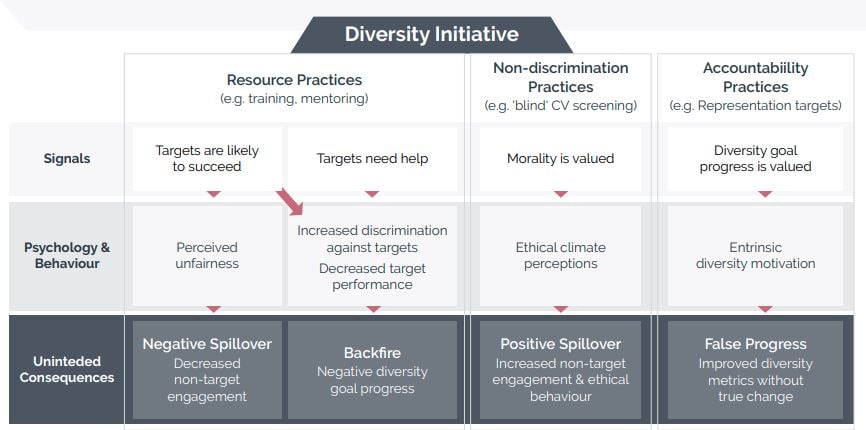
Backfire:
This is when an organisation implements something that causes a setback in diversity progress. For example, support is offered to women to address systemic biases which has resulted in a deficiency of women at senior levels of an organisation, but because of this they become even less likely to be given leadership opportunities due to this creating the perception that this support is offered because women need help due to having inferior leadership capability.
Negative spill-over:
This describes negative effects on outcomes other than diversity goal progress. For example, an initiative to support a minority group causes backlash in the form of negative reactions from a majority group due to perceived unfairness and/or preferential treatment to members of the minority group.
Positive spill-over:
This is a positive unintended consequence, where desirable effects on outcomes other than diversity goal progress are generated. For example, favourable reactions are created amongst the majority (non-target group) because they interpret this as showing that they work for a good employer.
False progress:
This is where it appears that we’ve improved DE&I, because the diversity metrics have improved, but there has been no true change in peoples’ attitudes, experiences, and outcomes. Applied to gender diversity targets, for example, it applies in situations where more women are appointed to leadership roles, but in a work context where discrimination, stereotypes and other biases still prevail. This reflects false progress, because whilst on the surface the organisation may appear more diverse, women’s experience is likely to be poor, and their performance impeded because of explicit or implicit discrimination, microinequities or stereotype threat preventing them from being at their best.
How do we avoid unintended consequences?
Ensure that your approach to managing DE&I is inclusive.
Think about the impact of DE&I initiatives and management practices on members of majority and minority groups on different intersecting dimensions, across your organisation. Aim to create an inclusive culture, ensuring that both underrepresented and dominant groups are accounted for in diversity management. Focusing on minority groups can result in a ‘backlash’ from the majority groups, triggering counterproductive outcomes such as the perception of ‘positive discrimination’ and ‘tokenism’. However, this shouldn’t mean that you cannot offer support tailored for any specific group in recognition of the specific biases that they are likely to be facing. Instead, take care to help everyone understand that certain groups of people are likely to face unique challenges due to specific biases or stereotypes, and therefore it is appropriate to offer support to those groups in navigating such challenges. In addition, if others wish to attend these sessions or access this support, then they should have access to the same or similar resources. Above all, an organisation-wide communication and education strategy is critical when it comes to DE&I, because unless people all appreciate the need for such interventions and support, there is a risk of backfire and negative spill-over.
Know what impact you’re having (or not having).
As with any investment of time and resources, and particularly where it’s important that progress is made, it is important to conduct a robust evaluation of any steps implemented, to check that they’re working. As we’ve discussed, DE&I is a complex and challenging issue to address, so even when implementing evidence-based strategies that have been proven to work elsewhere, it is essential to test how they’re landing within your specific context.
But where to start?
Start with the end in mind. Consider where, as an organisation you want to be, before assessing where you are starting from. Our maturity framework approach helps you to map out the key elements of a diverse and inclusive organisation, and against each, provides a pathway towards achieving maturity in terms of DE&I management. It provides clarity on where you want to be, but also key milestones to reach on the journey there.
Create an intervention map. Underpin your DE&I management strategy with an intervention map, or logic model, to ensure that you’re clear on what you’re doing, why, what impact you expect it to have (specifically), and how you will measure this. Ensure that this separates out inputs and outcomes – both short- and long-term. This will help you target your interventions and guide your evaluation, providing clarity on why you’re investing resources in each element of your DE&I management strategy, and how you expect it to have an impact.
Measure and re-measure on multiple levels. To gauge what, if any, impact you’re having, you need a baseline. You then need to measure again at different intervals over time on order to detect change in this baseline. Typically, you will be aiming to impact several different outcomes and you need to be able to measure all of these different outcomes, and to paint a full picture, may require both quantitative and qualitative data. Often, numerical data will tell you what or how much something has changed, but the narrative will help you understand why – or crucially, why not.
If you are interested in finding out more about how we can make your DEI&B investments matter, please contact us at sayhello@t-three.com
To find out more on Diversity, Equality and Inclusion, download our brand-new eBook.
How would you like to start a conversation? Click on the icons below, or use our interactive video tool.